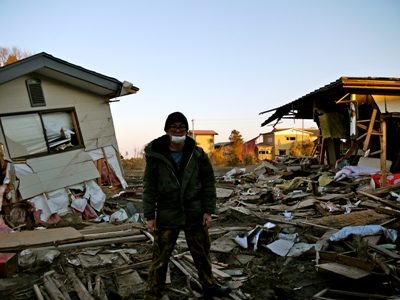Following up on our post about the difficulties of covering the aftermath of the Japanese earthquake from outside the mainstream media, CPJ spoke with intrepid freelancer Hiro Ugaya, whom we first interviewed in 2010. “From April 2 to 8, I was traveling in tsunami-destroyed area in Tohoku, northeastern Japan,” he told CPJ by email from Tokyo.
We asked Ugaya to share his experience of reporting without the support of a media outlet, relying on Internet resources like Facebook, Twitter, and photo-sharing websites. Ugaya offered a selection of photographs to share with CPJ readers, posted in a slideshow on the CPJ Blog. What follows is his account.
“The first thing I did was grab my camera”
Minor tremors happen once every week in Tokyo. At the moment, the big tremor came at 14:46 on March 11, 2011. I was sure this earthquake was something unusually intense and hundreds would be killed because I remember how the Kobe earthquake hit in 1995.
I was at home at the kitchen table, checking Twitter on my MacBook. When the first tremor ceased, the first thing I did was to grab my still and video camera and run outdoors to shoot photos of people with frightened faces sitting on streets, the cracked houses, walls and streets in my neighborhood, and my study flooded with fallen books and a cracked wall.
Until April 2nd, I could not leave Tokyo and travel to the Tohoku coast disaster zone. Firstly, I was busy covering the problems in Tokyo–aftershocks were coming continuously. Blackouts. Train cancellations. Commuters-turned-refugees without transportation to get home from offices in the heart of Tokyo.
Secondly, telecommunication lines from the disaster areas were all dead. So I could not obtain enough information about which area I could visit which had stable supplies of gasoline, water and foods. After the Kobe earthquake in 1995, many members of the press and volunteers rushed into Kobe without bringing gas, food or water supplies with them, and they ended up with their own ‘second disaster.’ I played safe.
After that, I financed myself and started for the disaster area without any offer from a media outlet, because I thought I would be too late if I waited for a media outlet offer or contract. In visiting the scene, “the sooner, the better” is the golden rule of emergency news coverage.
Fortunately, after I started opening my photos of disaster area on Facebook, many readers have been donating money through PayPal and bank transfer to me. By now, my field research expenses have been paid by the donations. It is a very rare and precious instance that I, at least, have never heard of before.
I am still highly concerned about radiation and aftershocks, even while I am in Tokyo. When I was in the disaster areas, I was frightened. Wave barriers were found crashed and gone. If a second hit had come, I would have been one of the victims.
Contrasting mainstream coverage
I saw no other members of the press. The small fishing village named Noda Mura in Iwate Prefecture, where I spent three days, had never received media attention except for one or two short articles in local newspapers. No national papers or TV stations had visited the village, not to mention foreign press, presumably because the damage of the village was relatively “small.” But I contacted some local people thorough Twitter and learned that half of the village was wiped out. Checking on Internet websites, I found out 38 people were killed in the tsunami, and 400 lost their homes, out of a population of 4,650. Many people were still suffering.
As usual with the Japanese national and municipal governments, the prime minister’s offices’ release of information was “too little, too late.” I presume the government tried to make the damages sound as minimal as possible, maybe not to cause public panic or simply because they are reluctant to show the failures they have made.
The mainstream media (mostly newspapers and television) fatally lack the mind-set of questioning authority and skeptical thinking. Consequently, they behave like an outsourced government PR division. At the very least, the prime minister’s office press conference should be open for the foreign press and freelancers. The mainstream media are too cooperative with the government and other authorities, such as electric power companies and their lobbyists.
